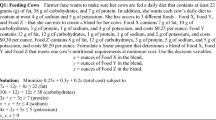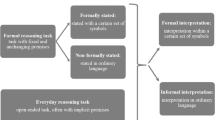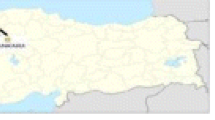Abstract
Several recent ascertaining studies revealed a deep-rooted and almost irresistible tendency among 12–16-year old students to improperly apply the linear or proportional model in word problems involving lengths, areas and volumes of similar plane figures and solids. While these previous studies showed to what extent students' improper use of linear reasoning is affected by different characteristics of the task, it remained largely unclear what aspects of their knowledge base are responsible for the occurrence and strength of this phenomenon and how these aspects relate to other more general misconceptions and buggy rules identified in the literature. This paper reports an in-depth investigation by means of individual semi-standardised interviews aimed at analysing the thinking process underlying students' improper linear reasoning and how this process is affected by their mathematical conceptions, beliefs and habits. During these interviews,students' solution processes were revealed through a number of well-specified questions by the interviewer with respect to one single non-linear application problem, as well as through their reactions to subsequent kinds of cognitive conflict. The interviews provided a lot of information about the actual process of problem solving from students falling into the ‘linearity trap’ and the mechanism behind it. Although some students seem to really ‘believe’ that quantities are always linked proportionally, their improper use of linearity often results from superficial and intuitive reasoning, influenced by specific mathematical conceptions, habits and beliefs leading to a deficient modelling process.
Similar content being viewed by others
REFERENCES
Berté, A. (Réd.): 1987, Enseignement des mathématiques utilisant la ‘réalité', Tome 1, IREM, Bordeaux.
Berté, A.: 1993, Mathématique dynamique, Nathan, Paris.
Brousseau, G.: 1984, ‘The crucial role of the didactical contract in the analysis and construction of situations in teaching and learning mathematics’, in: H.G. Steiner (ed.), Theory of Mathematics Education, Occasional Paper 54, Institut für Didaktik der Mathematik, Bielefeld, Germany, pp. 110–119.
Burkhardt, H.: 1994, ‘Mathematical applications in school curriculum’, in T. Husen and T.N. Postlethwaite (eds.), The International Encyclopedia of Education, Pergamon Press, Oxford/New York, pp. 3631–3634.
Collins, A., Brown, J.S. and Newman, S.E.: 1989, ‘Cognitive apprenticeship: Teaching the crafts of reading, writing, and mathematics’, in L.B. Resnick (ed.), Knowing, Learning, and Instruction. Essays in Honor of Robert Glaser, Lawrence Erlbaum Associates, Hillsdale, NJ, pp. 453–494.
De Bock, D., Van Dooren, W., Verschaffel, L. and Janssens, D.: 2001, ‘Secondary school pupils’ improper proportional reasoning: An in-depth study of the nature and persistence of pupils’ errors’, Proceedings of the 25th International Conference of the International Group for the Psychology of Mathematics Education, Vol. 2, Utrecht, The Netherlands, pp. 313–320.
De Bock, D., Verschaffel, L. and Janssens, D.: 1998, ‘The predominance of the linear model in secondary school students’ solutions of word problems involving length and area of similar plane figures’, Educational Studies in Mathematics 35, 65–83.
De Bock, D., Verschaffel, L. and Janssens, D.: 1999, ‘Some reflections on the illusion of linearity’, Proceedings of the 3rd European Summer University on History and Epistemology in Mathematical Education, Vol. 1, Leuven/Louvain-la-Neuve, Belgium, pp. 153–167.
De Bock, D., Verschaffel, L. and Janssens, D.: 2002, ‘The effects of different problem presentations and formulations on the illusion of linearity in secondary school students’, Mathematical Thinking and Learning 4(1), 65–89.
de Lange, J.: 1987, Mathematics, insight and meaning, OW&OC, Utrecht.
Fischbein, E.: 1987, Intuition in Science and Mathematics, D. Reidel, Dordrecht.
Forman, E.A. and Cazden, C.B.: 1985, ‘Exploring Vygotskian perspectives in education. The cognitive value of peer interaction’, in J.V. Wertsch (ed.), Culture, Communication, and Cognition: Vygotskian Perspectives, Cambridge University Press, New York, pp. 323–347.
Freudenthal, H.: 1973, Mathematics as an Educational Task, D. Reidel, Dordrecht.
Freudenthal, H.: 1983, Didactical Phenomenology of Mathematical Structures, D. Reidel, Dordrecht.
Gagatsis, A.: 1998, ‘Solving methods in problems of proportion by Greek students in secondary education, ages 13-16’, Scientia Paedagogica Experimentalis 35(1), 241–262.
Gagatsis, A. and Kyriakides, L.: 2000, ‘Teachers’ attitudes towards their pupils’ mathematical errors’, Educational Research and Evaluation 6(1), 24–58.
Ginsburg, H.P., Kossan, N.E., Schwartz, R. and Swanson, D.: 1982, ‘Protocol methods in research on mathematical thinking’, in H.P. Ginsburg (ed.), The Development of Mathematical Thinking, Academic Press, New York, pp. 7–47.
Gravemeijer, K.: 1994, Developing Realistic Mathematics Education, Freudenthal Institute, Utrecht.
Greer, B.: 1993, ‘The mathematical modelling perspective on wor(l)d problems’, Journal of Mathematical Behaviour 12, 239–250.
Greer, B.: 1997, ‘Modelling reality in mathematics classroom: The case of word problems’, Learning and Instruction 7(4), 293–307.
Larkin, J.H. and Simon, H.A.: 1987, ‘Why a diagram is (sometimes) worth ten thousand words’, Cognitive Science 12, 101–138.
Leinhardt, G., Zaslavsky, O. and Stein, M.K.: 1990, ‘Functions, graphs, and graphing: Tasks, learning, and teaching’, Review of Educational Research 60(1), 1–64.
Limón, M.: 2001, ‘On the cognitive conflict as an instructional strategy for conceptual change: A critical appraisal’, Learning and Instruction 11(4-5), 357–380.
Markovits, Z., Eylon, B.-S. and Bruckheimer, M.: 1986, ‘Functions today and yesterday’, For the Learning of Mathematics 6(2), 18–24, 28.
Matz, M.: 1982, ‘Towards a process model for high school algebra errors’, in D. Sleeman and J.S. Brown (eds.), Intelligent Tutoring Systems, Academic Press, London, pp. 25–50.
National Council of Teachers of Mathematics: 1994, Curriculum and Evaluation Standards for School Mathematics, Author, Reston, VA.
Nesher, P.: 1996, ‘School stereotype word problems and the open nature of applications’, Selected Lectures from the 8th International Congress on Mathematical Education, Sevilla, Spain, pp. 335–343.
Outhred, L.N. and Mitchelmore, M.C.: 2000, ‘Young children's intuitive understanding of rectangular area measurement’, Journal for Research in Mathematics Education 31(2), 144–167.
Rouche, N.: 1989, ‘Prouver: Amener à l'évidence ou contrôler des implications?’, Actes du 7ème Colloque inter-IREM Epistémologie et Histoire des Mathématiques, Besançon, France, pp. 8–38.
Simon, M.A. and Blume, G.W.: 1994, ‘Building and understanding multiplicative relationships: A study of prospective elementary teachers’, Journal for Research in Mathematics Education 25(5), 472–494.
Streefland, L.: 1984, ‘Search for the roots of ratio: Some thoughts on the long term learning process (Towards ... a theory). Part I: Reflections on a teaching experiment’, Educational Studies in Mathematics 15, 327–348.
Tierney, C., Boyd, C. and Davis, G.: 1990, ‘Prospective primary teachers’ conceptions of area’, Proceedings of the 14th International Conference of the International Group for the Psychology of Mathematics Education, Vol. 2, Oaxtepex, Mexico, pp. 307–314.
Tirosh, D. and Stavy, R.: 1999a, ‘Intuitive rules: A way to explain and predict students’ reasoning’, Educational Studies in Mathematics 38, 51–66.
Tirosh, D. and Stavy, R.: 1999b, ‘Intuitive rules and comparison tasks’, Mathematical Thinking and Learning 1(3), 179–194.
Treffers, A.: 1987, Three dimensions. A model of Goal and Theory Description in Mathematics Instruction. The Wiskobas Project, D. Reidel, Dordrecht.
Van Dooren, W., De Bock, D., Hessels, A., Janssens, D. and Verschaffel, L.: 2002, ‘Remedying secondary school students’ illusion of linearity: A developmental research’, Proceedings of the 26th International Conference of the International Group for the Psychology of Mathematics Education, Vol. 1, Norwich, UK, p. 370.
Verschaffel, L., De Corte, E. and Lasure, S.: 1994, ‘Realistic considerations in mathematical modelling of school arithmetic word problems’, Learning and Instruction 4, 273–294.
Verschaffel, L., De Corte, E. and Vierstraete, H.: 1997, ‘Teaching realistic mathematical modelling in the elementary school: A teaching experiment with fifth graders’, Journal for Research in Mathematics Education 28(5), 577–601.
Verschaffel, L., Greer, B. and De Corte, E.: 2000, Making Sense of Word Problems, Swets and Zeitlinger, Lisse, The Netherlands.
Wertheimer, M.: 1945, Productive Thinking, Harper and Brothers, New York.
Wyndhamn, J. and Säljö, R.: 1997, ‘Word problems and mathematical reasoning: A study of children's mastery of reference and meaning in textual realities’, Learning and Instruction 7(4), 361–382.
Author information
Authors and Affiliations
Rights and permissions
About this article
Cite this article
De Bock, D., Van Dooren, W., Janssens, D. et al. Improper use of linear reasoning: An in-depth study of the nature and the irresistibility of secondary school students' errors. Educational Studies in Mathematics 50, 311–334 (2002). https://doi.org/10.1023/A:1021205413749
Issue Date:
DOI: https://doi.org/10.1023/A:1021205413749




